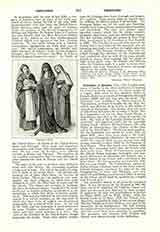

Ursulines of Quebec, the. —The Ursuline monastery of Quebec is the oldest institution of learning for women in North America. Its history begins on August 1, 1639, when its first members landed in Canada, thirty-one years after Champlain had founded Quebec (1608) and only four after his death. The monastery was established by Marie Guyard de l’Incarnation, declared Venerable by the Holy See (1874), and Madame de la Peltrie, a rich widow of Alencon in Normandy. The former, after ten years of widowhood, had joined the Ursulines at Tours. Her first biographer was her son, Dom Claude Martin, a Benedictine, who died in the odor of sanctity, in 1696. His “Life of the Venerable Mother of the Incarnation” was approved (1677) by the venerable Bishop Laval. Bossuet (Etats d’oraison, IX) calls Marie de l’Incarnation “the Theresa of her time and of the New World”. The letters royal sanctioning the foundation and signed by Louis XIII are dated 1639. After three years spent in the Lower Town, near Champlain’s Habitation, the nuns entered (1642) the convent built on the ground they still occupy, conceded to them (1639) by the Company of New France. Their first pupils were Indians, with whom they succeeded better than the Jesuits with their native boys. Marie de l’Incarnation mastered the difficult Indian languages thoroughly, and composed dictionaries in Algonquin and Iroquois, also a sacred history in the former, and a catechism in the latter idiom. The first monastery was burned in 1650, but was soon rebuilt. The Constitutions, written by Father Jerome Lalemant, uncle of the Jesuit martyr, Gabriel Lalemant, combined the rules of the two Congregations of Paris and Bordeaux, and were observed until Bishop Laval decided (1681) in favor of the former, which binds its members by a fourth vow to teach girls.
The monastery shared at all times the country’s fate. It was threatened by the Iroquois in 1661-62, when one of its chaplains, the Sulpician Vignal, was slain and devoured near Montreal by those savages. It underwent the siege and bombardment of Quebec by Phips (1690) and by Wolfe (1759). After the fateful battle of September 13, 1759, the French hero, Montcalm, was buried by night in the convent chapel. The first English governor, Murray, used part of the monastery as his headquarters. On that occasion the rations served to the nuns for nursing the wounded and sick saved them from perishing of starvation. The governors and viceroys, both English and French, were always friendly to the institution.
The foundress, who died in 1672, one year after Madame de la Peltrie, practiced devotion to the Sacred Heart of Jesus, and had established it in the cloister years before the revelation to the Blessed Margaret Mary. The first celebration of the feast in the New World took place in the monastery June 18, 1700 (Mandement of Bishop de St-Vallier, March 30, 1700). The register of the Confraternity of the Sacred Heart begins in 1716. Clement XI (1718) enriched it with indulgences. The first superior elected (1760) after the conquest was Esther Wheelwright, a New England captive, rescued from the Abenakis by the Jesuit Bigot, and a protegee of the first governor, Vaudreuil. Besides the French, the Irish, Scotch, and American elements in Canada have given distinguished subjects to this cloister, prominent among whom was Mother Cecilia O’Conway of the Incarnation, the “first Philadelphia nun”, one of Mother Seton’s earliest associates. The list of alumnae is not less remarkable. Conspicuous among its pupils were Jeanne Le Ber, the saintly “recluse of Montreal”, and Venerable Mother d’Youville, foundress of the Grey Sisters at Montreal. The Quebec monastery founded convents at Three Rivers (1697), Roberval (1882), Stanstead (1884), and Rimouski, with a normal school (1906), besides sending missionaries to New Orleans (1822), Charlestown (Boston) (1824), Galveston (1849), and Montana (1893). During the Revolution several French refugees were chaplains to the monastery, the most notable being Abbe L.—P. Desjardins, who died in France, Vicar-General of Paris. Through him were procured the valuable paintings by Philippe de Champaigne, Lebrun, Collin de Vermont, Peter of Cortona, and others, that adorn the chapel.
LIONEL LINDSAY

